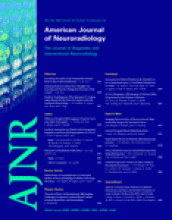Abstract
BACKROUND AND PURPOSE: Our aim was to evaluate the safety and clinical utility of a fluoroscopically guided anterolateral oblique approach technique for outpatient diagnostic and therapeutic selective cervical nerve root blockade (SCNRB).
MATERIALS AND METHODS: During a 13-year period (1994 through February 2007), 4612 patients underwent fluoroscopically guided diagnostic and/or therapeutic extraforaminal SCNRB by using an anterior oblique approach at affiliated outpatient imaging centers. Each procedure was performed by 1 of 6 procedural radiologists, all highly experienced in and actively performing spinal injections on a full-time basis in clinical practice. All of the proceduralists were thoroughly experienced with lumbar injections before endeavoring to perform SCNRBs. Nonionic contrast was injected in nearly all patients (except isolated patients with contrast allergy), and a minimum of 2 projection filming procedures were performed to document the accuracy of needle placement and contrast dispersal before the injection of therapeutic substances. All clinically significant complications beyond skin discoloration and temporary exacerbation of symptoms were recorded.
RESULTS: There were no serious neurologic complications, such as stroke, spinal cord insult, or permanent nerve root deficit. One life-threatening anaphylactic reaction occurred and was attributed to the injected materials and not the specific procedure itself. Another patient had a 3- to 4-minute grand mal seizure, from which he fully recovered within 30 minutes. There were no infections.
CONCLUSION: The technique we describe for fluoroscopically guided SCNRB is a useful and safe outpatient procedure when performed by skilled and experienced proceduralists.
- Copyright © American Society of Neuroradiology












